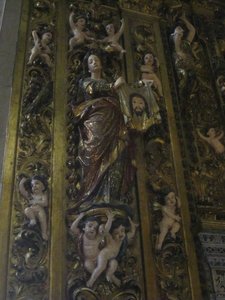Advertisement
Published: July 16th 2013

 Veronica
Veronica
In Lisbon, in a chapel in Sao Roque Church. I like it because it perfectly explains what "Veronica" means, the "true image." She gave Christ a cloth to daub his face when he fell while carrying the Cross. So she holds a "true image" of Christ... or is Veronica. Today I focused on the sights just down the Tagus River from Lisbon, in an area called Belem. This is the true heart of old Lisbon, back in the early 1500s when Portugal discovered the sea route to India, and the country became incredibly rich. Massive buildings projects appeared, including the famous Jeronimos Monastery. This place stretches for an entire block, and contains incredible cloisters done in what is called the Manueline style, after the Portuguese king at the time of all the sea voyages. It's basically just defined by really ornate decorations, and a lot of symbols relating to the sea, like ships and ropes and such. The Monastery also contains the tomb of Vasco da Gama, the man who discovered the route to India in 1498. Also in the area is the Belem Tower, the last sight sailors saw on the journey out to the ocean, and the massive Monument to the Discoveries, a more recent addition.
Largely spent the rest of the day walking around, first leaving Belem and going to the Museum of Ancient Art. I'm not really sure where the ancient art is in the museum, since I think the earliest dates from something like

 Ceiling at Sao Roque
Ceiling at Sao Roque
Also interesting because it's actually completely flat. It was painted to look like there's a dome. Called trompe l'oeil. the 1500s, but it does contain a nice selection of paintings, including the famous Temptation of St. Anthony by Hieronymus Bosch. This is a three-panel work and basically is an image of hell, with wild, unexplainable things happening, and weird combinations of people and animals. A lot of detail, and could spend a long time looking at. Also wandered around the Alfama area of town, which basically is an old section filled with winding lanes. I honestly wasn't that impressed. It really wasn't all that quaint, and to me more just seemed like a somewhat run-down part of town that for some reason smelled strongly of fish. But maybe I was just tired by this point in the day, and didn't the Alfama enough of a chance.
Tomorrow I leave Lisbon on the bus, heading North, towards Spain, stopping in Fatima and Coimbra.
Advertisement
Tot: 0.115s; Tpl: 0.011s; cc: 7; qc: 52; dbt: 0.0869s; 1; m:domysql w:travelblog (10.17.0.13); sld: 1;
; mem: 1.1mb

 Veronica
Veronica
 Ceiling at Sao Roque
Ceiling at Sao Roque






















